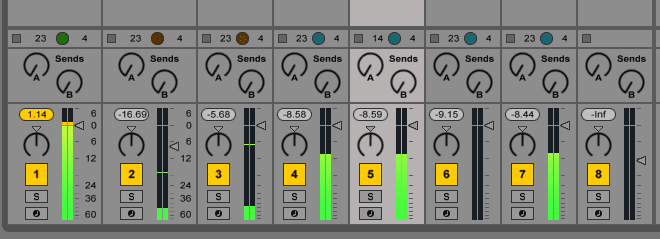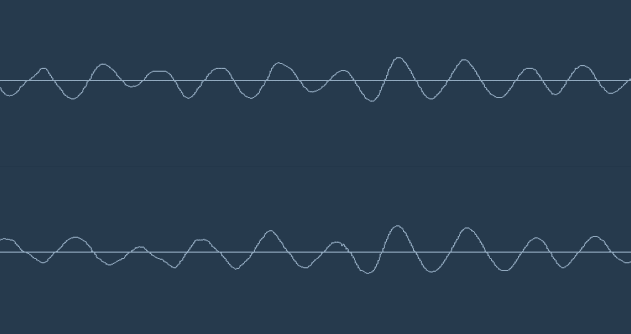Peak vs RMS and AC vs DC
One of the issues we have with audio is that we’re never dealing with static (DC – direct current) voltage levels. Audio signals are in a constant state of flux (AC – alternating current). So, whilst a sine wave may have a maximum amplitude of 1V when measured at its peak, an instantaneous measurement at another point in time may read anywhere between 1V and -1V. In fact, the average voltage of any symmetrical waveform will be 0V – not much use for conveying any sensible information.
For these varying signals that swing from positive to negative, a more meaningful representation may be useful – RMS (root mean square).
For our purposes, RMS is best thought of as average perceived level.
In relation to metering of musical material – consisting of constantly changing waveform shapes and amplitude – it allows us to visualise something closer to the loudness of a track.
For example, a piece of audio may reach a peak value for a fraction of a second, but this tells us nothing about how we might actually hear it.
Some compressors make use of this averaging by giving an explicit choice to use peak or RMS values in their detection stage, with RMS being more commonly used for a more sympathetic and less aggressive gain reduction.
Line vs mic level, balancing and consumer vs pro
Audio signals come in a wide range of levels. In order to bring all of these signals together to create a finished product, we need to address the differences.
Microphones convert changes in air pressure (physical movement of the diaphragm) into the flow of electricity. As the movements are small, the final voltage presented at a microphone’s output will be small. In this instance a mic preamp is used to amplify this small signal to something more workable.
Synths, drum machines and other electronic kit, on the other hand, already works at higher levels in terms of signal strength throughout the analogue stages of the circuit (which means after the digital-to-analogue converter in the case of equipment which generates sound digitally), so will output a so-called line level signal.
Loudspeakers sit at the opposite end of the spectrum to microphones, and require some serious power to make them move. In order to generate a decent enough sound pressure level to be useful, power amplifiers are used to amplify a line level signal from a mixing desk or computer’s audio interface. (The vast majority of studio monitors are now active designs, with a line level input to the speaker itself and a power amplifier built into the unit.)
Whether a signal is balanced or unbalanced isn’t directly decided by its level, but it’s closely enough related to warrant mentioning it here. Balanced cabling uses an additional conductor which carries an inverted version of the main signal. When re-inverted and mixed with the original at the receiving end it results in a larger signal, with any induced noise picked up along the way cancelled out and effectively removed. This is most important when dealing with low-level signals such as those from a microphone, but you’ll also find balanced inputs and outputs on a large proportion of pro audio gear.
And what does pro mean in this case? It’s partly, yet again, a matter of signal level. The generally accepted ‘professional’ standard line level is +4 dBu (which equates to an RMS voltage of 1.228V or 3.47 V peak-to-peak). Somewhat confusingly, ’consumer’ level is generally conveyed using a different dB scale (dBV). The consumer standard is −10 dBV (0.3162 V RMS or 0.894 V peak-to-peak), which equates to −7.78 dBu. For the sake of simplicity, you’ll often hear them referred to simply as +4 (‘plus four’) for profession and -10 (‘minus ten’) for consumer. Both can be used in the same setup, but the levels will have to be matched accordingly. Note that the use of the +4 dBu line level doesn’t necessarily guarantee balanced inputs and outputs.


06.43 AM
Came expecting Avicii.
Jah bless.
07.09 AM
Wow, seriously in-depth introduction and then some. Thanks Attack. Blowing away the ‘competition’ again.
09.22 AM
Thanks for this attack! great read, as always. this gs-thread probably adds some interesting details, too: https://www.gearslutz.com/board/so-much-gear-so-little-time/463010-reason-most-itb-mixes-don-t-sound-good-analog-mixes-restored.html (the title is a bit misleading, there is an in-depth explanation of the technical process behind the summing in a daw, check out the posts by paul frindle and skip burrows) I’m not sure about it, but shouldn’t the gain on the individual tracks be about -20 dB rms / -10 to -6 dB peak? i think 0 dbfs on each track can overload most plugins, as there are inter-sample-peaks and probably peaks that are caused by the processing in the plugin. would be interesting to hear your opinion about that. anyway, thanks again, and keep up the good work!
09.42 AM
Rob – thanks for the link. Yes, that kind of range seems about right for a safety-first approach.
01.09 AM
Good article guys! Here’s another great read about gain staging in a digital environment: http://www.masteringmastering.co.uk/gainstructure.html
11.37 AM
great article!
12.42 AM
I’m learning so much from this Guide, this is good stuff thanx man…!!!
02.41 PM
That mastering engineers article explains it all really well. I love Attack mag keep up the good work.
03.10 PM
Highly educational, thanks!